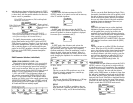
and light brown characters below the buttons for FUNC-
TION mode parameters. A brief example for two buttons
is shown here, with the specific references for these two
buttons noted in parentheses:
Violet EDIT mode parameters (Pitch and Amplitude
Modulation Sensitivity)
Reverse printed
EDIT mode Voice
Name character
(E&F)
Brown FUNCTION mode parameters (SAVE all 32
voices from internal memory to cartridge, or LOAD 32
voices from cartridge to the internal memory)
To simplify the presentation, we have further sub-
divided these buttons into the EDIT (violet) and FUNC-
TION (brown) groupings. Therefore, if you don't see the
operational description that applies to what you're doing
with a particular button as you read through the para-
graphs on the EDIT parameters, check the correspond-
ing button in the FUNCTION parameter descriptions
(and vice-versa).
Edit Parameter Selection (violet labels)
OPERATOR ON/OFF-EG COPY (1-6)
These buttons have two functions, (a) to turn individ-
ual operators on and off while you are programming a
voice, and (b) to designate the operator into which you
wish to copy an envelope. When you are in the EDIT
mode, the top center portion of the LCD display shows 6
number 1's or 0's, corresponding to the 6 operators:
1 =ON, and 0=OFF To toggle operator's output on or
off, press the corresponding [OPERATOR ON-OFF]
button. To copy the envelope, set the operator whose
envelope you wish to copy as the current operator using
[OPERATOR SELECT], then press [STORE] and hold
it while pressing [EG.COPY] button for operator 1 to 6;
all 4 rates and levels are instantly copied.
ALGORITHM
In EDIT mode, this button activates the [DATA
ENTRY] section so its controls can be used to select any
of the 32 available algorithms.
FEEDBACK
In EDIT mode, this button activates the [DATA
ENTRY] section so its controls can be used to alter the
amount of feedback in whatever algorithm is displayed
from none (0) to a maximum value (7).
LFO
In EDIT mode, these 6 buttons each activate the
[DATA ENTRY] section so it can be used to program or
edit individual voices with regard to Low Frequency
Oscillator modulation. When the modulation is used to
change the pitch, vibrato can be obtained. When it is
used to change the amplitude of a carrier, tremolo may
result; changing the amplitude of a modulator can create
"wah-wah."
WAVE
This lets you set the LFO waveform to any of the
following: triangle, sawtooth down, sawtooth up,
square, sine, sample & hold.
SPEED
This lets you adjust the LFO frequency in a 100 step
range, 0 being the slowest and 99 the fastest.
DELAY
This lets you set the LFO so modulation does not
begin until after a specified time after you press the
key, 0 being no delay, and 99 the maximum delay.
PMD
This lets you set the Pitch Modulation Depth. This is
the amount of modulation that will be applied to shift
the pitch of whatever notes are played (according to
the set waveform and speed). However, the modula-
tion can only affect the note if the pitch modulation
sensitivity is set to a value greater than zero (see
[MOD SENSITIVITY-PITCH]).
AMD
Like PMD, this button lets you set the Amplitude
Modulation Depth, the amount of modulation that
will be applied when you play but it affects the
amplitude (level), not the pitch. Likewise, the modu-
lation can only affect the note if the Amplitude modu-
lation sensitivity is set to a value greater than zero
(see [MOD SENSITIVITY-AMPLITUDE]). The same
LFO speed and waveform controls both the [PMD]
and [AMD].
SYNC
This lets you turn on or off the LFO Key Synchroni-
zation. When Sync is ON, the LFO is automatically
reset to the beginning of the selected waveform each
time you play a note. When sync is OFF the LFO
waveform continues, and when you play a note, the
result will vary depending on where the LFO is in
the cycle. The effect can be easily detected at low
LFO frequencies (SPEED settings below 10).
MOD SENSITIVITY
In EDIT mode, this pair of buttons activate the [DATA
ENTRY] section so it can be used to set the sensitivity
of individual voices to LFO modulation. The modulation
sensitivity is like a master control for all the modulation,
whether it is "built into" the voice with the adjacent
[AMD] and/or [PMD] buttons, or whether it comes from
the "real time" modulation controls such as the Modula-
tion Wheel, the Foot Control, the Breath Control or the
keyboard After Touch. If the Pitch or Amplitude Modula-
tion Sensitivity is set at zero, then none of the external
controllers can affect the voice, regardless of how much
Depth is set with their FUNCTION mode controls.
White PLAY mode
voice number (15
&16)
6


















